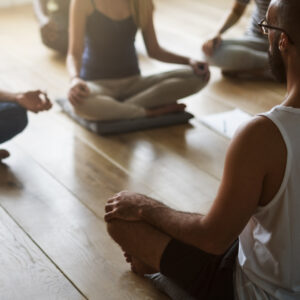The Benefits of Yoga and Pilates to Your Orthopedic Health

Yoga and Pilates have been shown to reduce orthopedic pain and improve balance, flexibility, strength, and your overall health. It’s no wonder then that these two practices rank as the most popular fitness classes in the nation.
Both yoga and Pilates preach whole-body wellness and encourage you to consider your mind, body, and spirit when searching for ways to improve your health, but each practice’s approach, techniques, and benefits are decidedly different.
Before you search for a yoga or Pilates class near you, it’s good to understand what’s involved. This blog by Orlin & Cohen licensed physical therapists Nicole Kerr, PT, DPT, and Chelsea Harms, PTA, is a great place to start. Then speak to your physical therapist or Orlin & Cohen orthopedic specialist.
What are the benefits of yoga?
An ancient and complex practice, yoga has evolved into a popular low-impact exercise that can promote physical and mental well-being. When practicing yoga, you typically adopt a position, and hold it or flow into a different one. There are many different yoga styles – from gentle to physically demanding – and each offers its own potential health benefits.
Improves strength, flexibility, and mobility
To improve strength, consider Hatha yoga, a style that involves long-duration static posturing, challenges your isometric strength, and improves your tendon loading ability. Bikram (or 26 + 2) yoga also focuses on long-duration static postures but adds a heated environment (above 102°F) for optimal muscle lengthening.
Looking to improve your flexibility or mobility? Consider Yin yoga or Vinyasa flow. In Vinyasa flow, you seamlessly move through a string of poses to create fluidity in movement, which helps improve mobility and completion of everyday tasks. Yin yoga focuses on more slow and passive postures; you hold each for at least 30 seconds using breathing techniques and props to deepen your range of motion and improve flexibility.
Reduces stress and pain
By improving flexibility, mobility, and strength, Vinyasa flow creates a foundation for optimal movement and reduces pain. Yin yoga’s focus on mindfulness can also reduce stress and anxiety, which can contribute to chronic pain.
Restorative yoga is another option if you’re looking to reduce stress. Typically a 45-minute to one-hour class that challenges your mental and physical awareness and focuses on mindful breathing, which has been shown to reduce stress and improve mobility.
Orthopedic yoga poses
While yoga poses of all styles may be beneficial to your health, certain poses are optimized to promote joint health and pain-free movement. Here are three of them. Again, it’s best to talk to your Orlin & Cohen physical therapist or orthopedic specialist before beginning your yoga practice.
Viparati karani (legs up wall)
Lie on your back with your hips about 10 inches from the wall. Interlock your fingers under a bolster. Lift your right heel and place it over your left toes to encourage toe-joint flexion. Repeat on the other side.
Warrior pose
Stand with your legs wide apart like though you’re about to head into battle. Bend your knees, elevate your shoulders, and extend one arm in front of you and one behind. This pose helps increase balance and strengthen knee joints.
Savasana (corpse pose)
This is the final pose of most yoga practices. Lie on your back and separate your legs so your feet fall open on either side. Bring your arms alongside your body, slightly separated from your torso. Face palms up and let your fingers curl in. Tuck your shoulder blades onto your back for support. Relax. Breathe naturally. Stay for a minimum of five minutes.
What are the benefits of Pilates?
Often recommended to build strength or rehabilitate after an injury, Pilates involves slow movement within a controlled range of motion. In Pilates, you assume a position and then challenge your core by moving your arms or legs. This challenging low-impact method balances strength with mobility, aligns the body, fine-tunes movement patterns, and strengthens the deeper muscles of the core.
Improves strength, flexibility, and posture
Pilates’ ongoing focus on movement control and developing your core makes it an effective method for increasing strength and flexibility and for maintaining optimal body alignment to improve posture.
Decreases back pain
With Pilates, you concentrate on controlling your breathing and recognizing areas of tension, which can help your body relax and reduce the soft tissue tightness that causes pain. Its slow and controlled movements also strengthen your pelvic floor and deep abdominal muscles, which has been proven to improve chronic low back pain.
Helps strengthen bones
By consistently using lower body and upper body weight-bearing postures – and challenging your core – Pilates leverages Wolff’s law, which states that healthy bones adapt and strengthen according to the load placed upon them.
Orthopedic Pilates movements
While virtually all Pilates movements can be good for your health, certain ones can be particularly effective in rehabilitating or preventing orthopedic injury. Here are three of them. Again, it’s best to talk to your Orlin & Cohen physical therapist or orthopedic specialist before you start any Pilates practice.
Single-leg circles
Strengthen your quadriceps and hamstrings and promote healthy hip joints with this exercise. Draw one knee to your chest and extend it straight toward the ceiling. Inhale and cross the extended leg up and over the body, toward the opposite shoulder, and over the outstretched leg. Exhale and lower the leg down toward the center line in a circling motion. Do five to eight circles with each leg, then reverse directions.
Criss cross
This is a great warm-up for runners and athletes. Lie on your back. Then, raise your legs into a tabletop with hips and knees at 90 degrees. Place your hands behind your head. Use your arms to lift your head off the floor. Exhale and extend one leg out straight with pointed toes as you twist your torso to the opposite knee. Inhale as you move through the middle. Alternate legs and repeat for 45 seconds.
Spinal twist
This pose is a simple way to strengthen oblique muscles and spine extensors and improve rotation of the spine. Sit with your legs out in front while you rotate your body around to one side, come back to the center, and then rotate to the other side. Repeat five times.
Not sure if Pilates or yoga is right for you? Request an appointment with an Orlin & Cohen physical therapist or orthopedic specialist.



